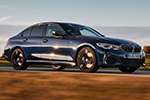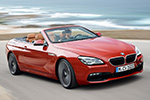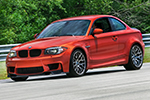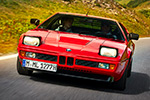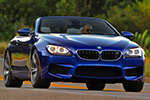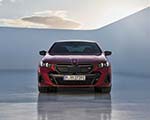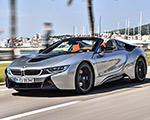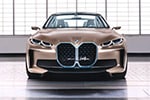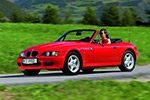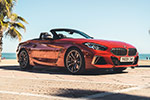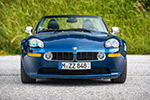The first thing I noticed wasn’t the power. It was the rain. Thick Southern downpour, the kind that turns every patch of asphalt into a mirror. The car sitting in front of me — the new 2026 BMW M2 CS — looked ready to destroy lap times, not wade through puddles. But that’s what made it perfect. There’s something cool about testing BMW’s most track-focused small coupe in conditions that erase grip altogether.
I slipped into the carbon bucket seat, adjusted the flat-bottom Alcantara wheel, and hit the starter. I hit the starter and the S58 came to life with that familiar straight-six pulse — deep, purposeful, and unmistakably M. The cabin picked up a low vibration through the seat and wheel, the kind that instantly tells you you’re in something serious.
Outside, the rain eased to a drizzle — just enough to tempt me onto the track.
Chassis Upgrades: 8mm Lower, M4 GT4 Mounts And More
Even before turning a wheel, you can tell the CS is different. It sits lower — 8 millimeters down on revised springs and dampers — and the stance alone gives away its intent. The engine and transmission mounts are stiffer, with the gearbox mounts borrowed directly from the M4 GT4 race car. The Active M Differential and stability systems have been reprogrammed, the traction control now offering ten levels of adjustment. Every piece of hardware has been tightened, sharpened, and tuned to make the car more communicative.
2026 BMW M2 CS
Good
- Outstanding traction and balance, even in the wet
- Sharper steering and chassis feedback than the base M2
- Dual personality: track weapon yet daily-drivable
Bad
- $20K premium puts it close to M4 territory
- Slight highway drone and firm ride
- No manual option or center armrest
From the outside, it’s a subtle evolution rather than a shout — though honestly, I wouldn’t have minded a bit more visual drama. The carbon-fiber roof, ducktail trunk lid, and redesigned diffuser make the regular M2 look tame without overdoing it. The forged wheels save unsprung mass, the lighter carbon parts chip away at the weight, and all told the CS sheds about 97 lbs (44 kg) versus the standard car, bringing it down to roughly 3,770 lbs.
Lots of Power: 523 hp, 479 lb-ft
BMW could’ve just added power and called it a day, but that’s not what happened here. The 523 horsepower and 479 lb-ft of torque are almost secondary to how alive the whole car feels. The connection between throttle, drivetrain, and chassis is instant — the response is so crisp that you feel the car breathe beneath you.
Wet Traction on Michelin Pilot Sport 4S
The first lap told me everything I needed to know. Even on Michelin Pilot Sport 4S street tires, the M2 CS launched like it was glued to the track. Traction in the wet was shockingly good — the rear would twitch under full throttle, then dig in, sending the car forward with a controlled violence that made me laugh out loud.
I spent most of those first laps in MDM. It’s the sweet spot on a wet day: the rear can breathe on corner exit, you still get rotation on a lift or a brush of trail brake, and it only tidies up the spikes. It trims torque instead of clamping the brakes, so the car never feels strangled. With M Traction Control in the middle of the range, I could steer it on the throttle and learn the surface instead of fighting it.
The Driving Experience Compared To The G87 M2
On corner entry, I could stand it on its nose under braking, rotate it around, and feed in power with precision. If the front started to push, a quick lift brought it right back. The balance was spot-on — playful, but always predictable.
Compared to the base G87 M2, which already feels planted and forgiving, the CS has more edge. It’s still stable, but it’s more eager to rotate. The stiffer mounts tie the whole car together and you can feel the powertrain and chassis working as one. And surprisingly to other modern BMWs, you get a lot of steering feel. More on that in a second.
And that’s the difference: the base M2 lets almost anyone go fast; the CS in MDM still plays along, but it also shows you how much more there is if you’re willing to lean on it.
Steering Feel: G87 vs. F87 M2 CS
Even with DSC fully off, it never felt intimidating, at least on the track. It liked to step out, sure, but always in slow motion — progressive, catchable, and immensely rewarding. The M Traction Control system deserves serious credit. In the right mode, you can dial in just enough slip to dance through corners without fear. It’s the kind of car that makes you want one more lap, just to see if you can get it a little cleaner next time.
The steering also feels better than in the G87 M2, but as expected, a bit less engaging than the F87 M2 CS I drove two years ago on a track nearby. It’s heavier than most modern systems, but not too artificial. It loads up naturally, giving you a constant stream of information from the pavement. You can feel the front tires clawing through the water, the weight transferring, the chassis leaning ever so slightly on its outside edge. There’s real communication here — the kind of engaging steering that’s becoming rare in many modern sports cars.
MDM Mode Was The Best
On the big track, with long sweepers and flat corners, the car felt so secure that by the third lap, I was already experimenting with new lines. That’s what a great M car does — it earns your trust quickly, then invites you to explore.
I kept MDM on for most of the morning. In the fast, flat sections it let the rear breathe a little, then gather itself up without killing speed. Once I knew where the grip was, I went DSC-off for a few laps — more laughs, more angle — but my cleanest laps actually came in MDM, because it kept the car tidy without feeling like a safety net.
Carbon-Ceramic Brakes Are Consistent and Fade-Free
The carbon-ceramic brakes were flawless. They stopped hard, lap after lap, even in the cold and wet, with zero fade. There was a faint squeal in the slower corners — almost like a reminder of how serious these brakes are — but pedal feel was perfect. Linear, firm, consistent.
As the session went on, the smell of hot rotors mixing with rain filled the cabin. The car hunkered down with every lap, the chassis feeling more settled, the tires finally finding heat. You could sense it coming alive.
Autocross: DSC Off vs. MDM
When the rain finally slowed, I turned off DSC completely and headed for the autocross course. The surface was still slick, but this was the M2 CS at its best. It rotated more eagerly now, the rear following the throttle with just the right amount of slip. Through the tighter corners, I could feel the front tires bite and the car pivot neatly around them — precise, but never clinical.
Funny thing is, on the tight autocross the quickest way around wasn’t DSC-off; it was MDM with a bit of slip dialed in. It let the nose bite, let the rear rotate just enough, and then cleaned up my greed on throttle. I could push harder without paying a time penalty for every little mistake.
The shorter wheelbase gives it this compact, tossable nature, yet it’s so well balanced that even big slides feel easy to control. The whole time, the steering wheel was alive in my hands, gently writhing as the car found grip, lost it, and found it again.
By the end of the session, I already knew what the M2 CS is all about: it’s not just a track weapon, it’s a car that reminds you the why we love combustion-powered sportscars.
On a dry track with Cup 2 or Cup 2 R tires, it would be devastatingly quick, though I suspect the firmer suspension and those ultra-sticky compounds might make it less friendly on bumpy or wet roads. On the 4S tires, it felt like the perfect compromise — plenty of grip, just enough forgiveness.
Daily Driving: Comfort Mode & Ride Quality
After a full morning of track work, I took the M2 CS out onto South Carolina’s back roads. I wanted to see how much of its personality survived outside the circuit. Everything set to Comfort mode, the car softened up instantly. The ride is firm, yes, but far from punishing. It soaked up rough patches and expansion joints without drama.
At about 55 mph, over patched asphalt, it stayed composed — communicating the road surface without beating you up. There’s a slight drone on the highway, probably from the reduced sound insulation, but it fades once the road turns interesting.
At 70 mph in eighth gear, the engine hums just under 2,000 rpm. Quiet, steady, completely livable. It’s surprisingly refined — a car you could commute in if you wanted to.
The Typical CS Cabin
The carbon bucket seats still hug tightly, but they’re heated, as is the Alcantara steering wheel. There’s wireless CarPlay, Android Auto, and charging ports. Sure, there’s no center armrest or cupholders, but honestly — you don’t buy a CS to drink coffee.
And despite its extra edge, the CS hasn’t sacrificed practicality. It still keeps the rear seats, which means you can carry passengers or luggage — not something every “track special” can claim.
Dual Personality: Calm in Comfort, Alive in Sport
It was on those back roads that I really started appreciating the duality of this car. It’s calm and obedient when you want it to be, but the moment you dial the settings back to Sport, the whole thing tightens, the throttle wakes up, and the steering feels like it’s reading your thoughts.
Just like on track, the M2 CS feels flatter through corners but also more alert. The first time you turn in, you notice how much sharper it is — precise and eager, yet still with that BMW flow that keeps you connected to the road.
Production, Price & Allocation
BMW hasn’t said how many M2 CS models will be built, but whispers suggest fewer than 2,000 units worldwide, with the U.S. getting most of them. Japan gets just 87 cars, all sold out already — a fitting nod to the G87 codename. Canada is said to have 81 units. Production runs through July 2026, built alongside the regular M2 in San Luis Potosí, Mexico.
It’s a $20,000 jump over the base M2 (MSRP $99,975), but you can feel exactly where that money went — in the way the chassis talks to you, how the car pivots mid-corner, and how it rewards small, precise inputs. And when you think about it, even at that price, there really isn’t a true rival in this segment — nothing else that blends this level of performance, balance, and everyday usability quite like it.
There is one thing missing though: the now iconic yellow lights.
Final Verdict: BMW M2 CS With Character & Soul
The F87 M2 CS was one of my favorite modern BMWs because it managed to combine sharpness with joy. This one feels like its spiritual successor. It’s faster, more composed, and yet it hasn’t lost that raw edge that made the original such a cult hit. Sure, it might slightly more controversial when it comes to its design, but performance wise, it’s certainly a step up.
BMW calls this car “CS” for Competition Sport, but I think it stands for something else: Character and Soul.
It’s everything a modern M car should be — compact, rear-driven, communicative, and full of personality. It’s not perfect. It’s firm in ride, it’s loud in design, it’s unapologetic. But it’s real.
And after a full day in the rain, chasing grip and grins in equal measure, I realized something: this is the M2 we’ve been waiting for — the one that reminds you why you fell in love with BMW M in the first place.
I could’ve kept driving it all day.
2026 BMW M2 CS
-
Motor: 3.0 liter inline-six
-
Power: 523 hp / 479 lb-ft @ 2,750 to 5,730 rpm
-
Transmission: Automatic
-
Drivetrain: RWD
-
Speed 0-60 MPH: 3.7 sec
-
Top Speed: 188 mph
-
Weight: 3,770 lbs
-
Cargo Volume: 13.8 cubic feet
-
Seating Capacity: 4
-
Base Price: $99,775

















































 Motor:
Motor:  Power:
Power:  Transmission:
Transmission:  Drivetrain:
Drivetrain:  Speed 0-60 MPH:
Speed 0-60 MPH:  Top Speed:
Top Speed:  Weight:
Weight:  Cargo Volume:
Cargo Volume:  Seating Capacity:
Seating Capacity:  Base Price:
Base Price: 















